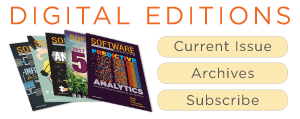By Jack Norris
While business intelligence (BI) is fairly mature, most of its insights today are descriptive rather than predictive and prescriptive. Because the past and present are not always prologue, BI is insufficient for enabling businesses to realize the full value from their investments in data analytics. And that insufficiency is destined to be filled with machine learning and artificial intelligence (AI) technologies that are already driving deeper insights than are humanly—pun intended—possible.
The AI-enabled smart business is one where data and analytics guide people and processes so that they continuously know the best action to take, and when to take it, to dynamically optimize business operations, minimize risk, maintain regulatory compliance, and cut costs—all while seizing opportunities and improving customer engagements in ways that maximize profitability.
Achieving the AI-enabled smart business involves disrupting the traditional management model, where most or all strategic decisions are made in the C-Suite, and relying more on a data-driven model that is self-learning, self-organizing, and self-optimizing—hence the need for machine learning (ML) and AI. In addition, gaining deeper insight will require ingesting and analyzing new sources of data, including structured ones like clickstreams, sensors and text, as well as semi-structured ones like JSON and XML.
While the results promise to be revolutionary, achieving them will require only evolutionary changes.
Getting There—Incrementally
The collection of analytical point solutions being used today is a good starting point, but building the AI-enabled smart business requires creating a comprehensive framework that leverages existing investments while laying a new foundation capable of utilizing data from the data center all the way to the edge of the enterprise. Having a framework facilitates making prudent investments in data and analytics to produce new, more insightful and deeper insights on a continuous basis.
Getting there will require incremental—and manageable—changes that gradually build a common and extensible analytical framework on top of an equally extensible common data fabric. The analytical framework should be designed to align the analytical and AI/ML workflows with the business strategy. The data fabric should encompass both data in motion and data at rest. The former includes streaming data at the edge, in the cloud and on-premises; the latter includes data in the cloud, as well as in on-premise data stores.
To facilitate the methodical, incremental building of an AI-enabled Smart Business, the fabric and framework should enable the implementation of separate data and analytics projects that all support specific, strategic business objectives. An example of a strategic business objective is reducing fraud. Ideally this objective would be quantified and eventually fulfilled by creating multiple fraud-reducing analytical projects, with each project focused on analyzing a specific data asset.
Delivering continuous improvements on a per-project basis makes it possible for the chief data officer (CDO) and other C-Level executives to see the value of individual AI and ML models, and how these can be combined and aligned to achieve a common business objective.
The key to success for an AI-enabled Smart Business is building both the analytical framework and the data fabric to be agile and fully extensible. Such agility and extensibility must accommodate all workloads—from data ingestion through training, inference, and action—and must also span the entire organization and its many data sources—from the edge to the core and in private, public and hybrid clouds.
The individual data, analytics, and decision workflows are pipelines that can be published as services in an information catalog and linked together in other workflows, potentially using the Kafka API. This enables microservices-based pipelines to be created and combined, culminating in the equivalent of a state machine that dynamically responds to events and continuously optimizes business operations to achieve multiple business objectives in a holistic manner.
Smart Business Benefits
Once achieved, the AI-enabled Smart Business will continue to evolve because the ultimate goal is to become not just smart, but self-learning, self-organizing and self-optimizing to continuously adapt and improve. The result is a data-driven business that is more informed, responsive, proactive and competitive.
Also among the benefits is the ability of the CDO to manage data and analytics projects, align them with business objectives, and assess how they are—individually and incrementally—delivering value to the business. This same visibility enables other C-Level executives to better appreciate how the investments being made in the AI-enabled Smart Business are contributing to achieving the organization’s strategic objectives. SW
Jack Norris is SVP, data and applications, MapR Technologies, where he drives understanding and adoption of new applications enabled by AI and analytics. With over 20 years of enterprise software marketing experience, his experience includes launching and establishing analytic, virtualization, and storage companies and marketing and business development for an early-stage cloud storage software provider. Norris has also held senior executive roles with EMC, Rainfinity (now EMC), Brio Technology, SQRIBE, and Bain and Company. He earned an MBA from UCLA Anderson and a BA in Economics with honors and distinction from Stanford University.
Sep2018, Software Magazine

